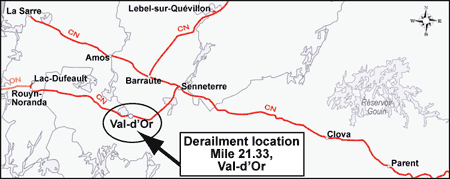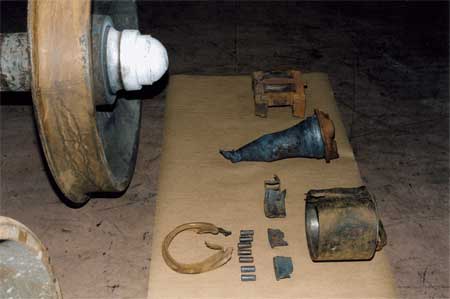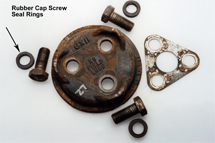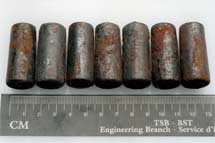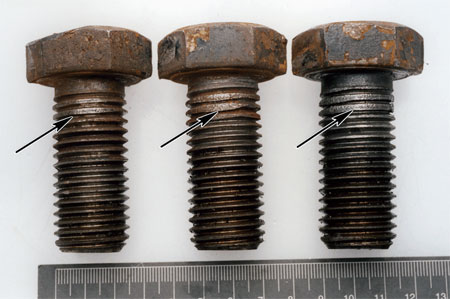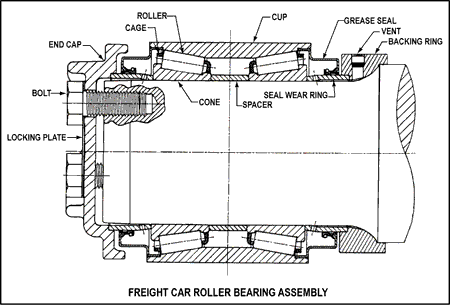Main-track derailment
Canadian National
Train L577-21-31
Mile 21.33, Val-d'Or Subdivision
Val-d'Or, Quebec
The Transportation Safety Board of Canada (TSB) investigated this occurrence for the purpose of advancing transportation safety. It is not the function of the Board to assign fault or determine civil or criminal liability. This report is not created for use in the context of legal, disciplinary or other proceedings. See Ownership and use of content. Masculine pronouns and position titles may be used to signify all genders to comply with the Canadian Transportation Accident Investigation and Safety Board Act (S.C. 1989, c. 3).
Summary
On 31 July 2005, at approximately 1316 eastern daylight time, Canadian National freight train L577-21-31, travelling westward at 31 mph, derailed nine cars at Mile 21.33 on the main track of Canadian National's Val-d'Or Subdivision. Seven of the derailed cars were bulkhead flat cars loaded with logs, and two were gondola cars loaded with copper concentrate. There were no injuries and there was no release of copper concentrate.
Ce rapport est également disponible en français.
Factual information
On 31 July 2005, Canadian National (CN) train L577-21-31 (the train) originated at Senneterre, Quebec, and was destined for Val-d'Or, Quebec (see Figure 1). It was powered by 2 locomotives, and was hauling 26 loaded cars, 10 empty cars and 19 residue cars. It was approximately 2940 feet in length and weighed about 3800 tons. The operating crew of the train consisted of one locomotive engineer and one conductor, both positioned in the cab of the lead locomotive. The crew members were qualified for their respective positions, and met company and regulatory fitness and rest standards. At Senneterre, a certified car inspection, a No. 3 air brake test, and a Schedule A inspection were performed. No irregularities were noted.
At approximately 1316 eastern daylight time,Footnote 1 as the train was travelling westward on the main track of CN's Val-d'Or Subdivision at 31 mph, a train-initiated emergency brake application occurred. After conducting the necessary emergency procedures, the crew determined that nine cars (the 5th to the 13th cars) had derailed. Seven of the derailed cars came to rest on their side; all derailed cars sustained minor damage. A switch at Mile 23.3, the east end of a wye track for a spur leading to a local mine (Louvicourt), was destroyed, and 450 feet of main and wye track was damaged.
At the time of the accident, skies were cloudy, with winds from the south-southwest at 10 km/h. The ambient air temperature was 18°C.
Train movements on the Val-d'Or Subdivision are governed by the Occupancy Control System (OCS) authorized by the Canadian Rail Operating Rules (CROR), and are supervised by a rail traffic controller located in Montréal, Quebec. The authorized timetable speed was 30 mph.
An analysis of the locomotive event recorder showed that, at the time of the derailment, the throttle was in idle position, train speed was 30 mph, and brake pipe pressure was 89 pounds per square inch (psi). Of note:
- at 1316:34, a train-initiated emergency brake application occurred;
- at 1316:36, brake pipe pressure was recorded as 0 psi; and
- at 1317:31, all locomotive movement had stopped.
The Val-d'Or Subdivision extends from Senneterre, Mile 0.0, to Rouyn-Noranda, Quebec, Mile 101.5. Between Mile 17.5 and Mile 20.8, the track has an ascending grade of approximately 0.4 per cent in the direction of train travel. Then, from Mile 20.8 to the derailment location, the track has a descending grade of 0.6 per cent. Other than a slight curve at Mile 18.4, the track is tangent throughout.
The track consisted of 132-pound continuous welded rail, laid in 1984. Standard 11-inch double-shouldered tie plates were secured by three six-inch spikes. Treated hardwood ties were laid with spacings of approximately 59 ties per 100 feet. The rail was anchored every second tie, and at every tie within 200 feet of the wye switch for the Louvicourt mine spur. The track structure rested on a three-foot subgrade fill, topped with crushed rock ballast. Current traffic levels on this subdivision are one million gross tons per mile of track. Dangerous goods movements include mostly shipments of petroleum products for local distributors and corrosives (such as acids and caustic soda) for pulp and paper mills.
On the Val-d'Or Subdivision, visual inspections were performed by an assistant track supervisor using a hi-rail vehicle. The last track inspection before the accident was performed on 28 July 2005, three days before the accident. The inspection report indicated that, in the vicinity of the derailment, some track bolts were tightened at Mile 21.30. No major defects were noted.
The first marks on the head of the rail were located approximately 90 inches west of a public crossing at Mile 21.33. Damage to the ties and rail fastenings were observed between Mile 21.33 and Mile 23.3, where the main pile-up occurred.
Derailed bulkhead flat car JRDX 490038,Footnote 2 the fifth car behind the locomotives, was missing a portion of an axle (position R-2). The axle journal along with the associated bearing was discoloured and had completely separated from the rest of its wheel set, a condition commonly described as a burnt-off journal, or BOJ. The truck side had marks indicating a recent impact on the bottom and on the trailing end of the side frame. There were no indications of impending bearing failure, such as grease spatter on the floor underframe immediately above the failed roller bearing location. The missing axle journal stub, with the bearing end cap still attached, was located on the south side of the main track at Mile 20.15.
The recovered pieces of the roller bearing (see Photo 1) and the adjacent wheel sets (No. 1 and No. 2 positions) were forwarded to the TSB Engineering Laboratory in Ottawa, Ontario, for further examination and analysis (report LP 093/2005).
Car JRDX 490038, transporting logs, was 57 feet in length, and was equipped with standard couplers and draft gear. It was stencilled for a gross rail load of 220 000 pounds and had last been air tested on 27 September 2003 by CSX Transportation Inc. in the United States. The shipping documents indicated that the weight of the loaded car was within allowable limits. It is not known whether its load was equally distributed because the contents had spilled from the car during the derailment. There was nothing unusual noted with the loading pattern of the other bulkhead flat cars loaded with logs.
Between the point of loading on the Saint-Maurice Subdivision and the derailment site on the Val-d'Or Subdivision, car JRDX 490038 travelled approximately 117 miles of its intended 144-mile journey. The car passed over one hot bearing detectorFootnote 3 (HBD), located at Mile 214.8 (Monet) of the Saint-Maurice Subdivision, 62 miles before the derailment, with no alarms generated.
Wheel and axle information
The wheel in the No. 2 position was a CJ33 type, mounted on a 6 X 11 axle. It was manufactured in September 1980 by Southern (ABC Rail) in the United States. No significant grease spatter was observed on either wheel plate. The wheel set "back to back" measurement was within specified limits. There were no significant shelling defects or other tread defects on either wheel.
The serial number of the R-2 wheel plate was 504605. The wheel flange thickness was 15/16 inch, which is the Association of American Railroads (AAR) wear criterion for a thin flange condition, but is within the allowable wear limits of the Transport Canada (TC)-approved Railway Freight Car Inspection and Safety Rules.Footnote 4 Mounting information stamped on the outer hub face of the R-2 wheel (9 ICG 80 C) indicated that the wheels were pressed on at the Illinois Central Gulf Railroad Centralia Shop in September 1980. The total accumulated mileage on the car since the wheel was applied was not available.
Axle markings (H B6409 U SSD I 80 7D) indicated that this was a normalized, quenched and tempered axle (H), serial number B6409, manufactured by Standard Steel Division (SSD) in January 1980, heat number 7D.
Roller bearings
Roller bearings consist of an outer race, two tapered roller bearings with inner races separated by a spacer, and two (inner and outer) grease seals with wear rings. This assembly is pressed on an axle against a backing ring and then retained by the end cap, which attaches to the end of the axle via three cap screws and a locking plate (see Photo 2 and Appendix A).
Roller bearings are designed to last the life of the wheel without further lubrication or other types of maintenance. The AAR does not require roller bearings to be removed based on any age or mileage criteria.
The bearings on wheel R-2 were Class E Brenco 6 X 11, AAR-5A. When they were assembled, they were equipped with rubber cap screw seal rings between the end cap and the axle. In May 1988, the AAR prohibited the further use of these cap screw seal rings as they were susceptible to reducing the clamping forces on the assembly, which can contribute to premature failure of the bearing. Examination of the end cap and related components from the R-2 position revealed only residues of these seal rings.
Both grease seals were recovered; the outer fused to the cup and the inner severely damaged. The roller bearings and the outer race were severely deformed and smeared, with some of the rollers fused to the inner race. Portions of the inboard inner race were recovered with rollers and cage sections fused together. Seven of the inboard tapered rollers were recovered, some showing surface spalling (see Photo 3). Closer examination of the inboard raceway of the outer race showed a significant spall on the outboard edge. Fretting wear was observed on the threads of the cap screws in the vicinity of their interaction with the end cap (see Photo 4).
CN undertook a survey at its Transcona wheel shop facility in Manitoba for a two-week period in March 2006 to assess the size of the fleet still equipped with cap screw seal rings. CN reported that, of an incoming flow of 2221 wheel sets (both CN and foreign), a total of 8 wheel sets were found to have roller bearings equipped with the rubber seal rings. This reflects a population of approximately 0.36 per cent of all wheel sets arriving at its shop for attention. CN considers this percentage to be statistically valid given the size of the sampling. CN also reported that, of the suspected hot bearings examined, there has been a steady decline each year in the percentage found that have rubber seal rings, as follows:
| Year | Percentage |
|---|---|
| 2003 | 5.2 |
| 2004 | 3.2 |
| 2005 | 1.2 |
Hot box detectors
Should a bearing begin to fail prematurely, track-side detection systems, such as HBDs and acoustic bearing detectors, as well as visual inspections by qualified persons, can identify and allow for the correction of defective bearing conditions.
CN has installed automated detection equipment such as hot box, hot wheel, and dragging equipment detectors, on main track on selected subdivisions. On heavy traffic CN subdivisions, these devices are now spaced 12 to 15 miles apart. On some subdivisions with lower traffic, such as the Saint-Maurice Subdivision, which extends from Fitzpatrick to Senneterre, the distance (interval) between adjacent HBDs measured 47.3, 92.9, and 53.9 miles. The Val-d'Or Subdivision was not equipped with HBDs nor acoustic bearing detectors.
The post-accident inspection determined that the HBD that scanned car JRDX 490038 at Mile 214.8 of the Saint-Maurice Subdivision was working as designed.
There are no regulatory requirements for railways to be equipped with HBDs. Before the Railway Safety Act of 1989, issues related to HBDs and the need to inspect rolling stock were addressed by a Canadian Transport Commission (CTC) order that was revoked in 1995. Although there are no regulatory requirements pertaining to the installation, inspection, calibration, and alarm levels for this equipment, in March 2003, TC introduced the Hot Box, Hot Wheel, Dragging-Equipment Detector Inspection/Audit Program Guide. This guide is used by TC's Rail Safety inspectors to conduct audits and inspections. During an audit, these TC inspectors review and document the procedures used by the railways to calibrate and maintain wayside inspection equipment.
TSB statistical data
A five-year review of TSB statistical data (2000-2004) revealed that there were on average 10 derailments per year caused by BOJs. The TSB database includes reportable occurrences involving a BOJ, normally when a derailment or collision occurs.Footnote 5
| 2000 | 2001 | 2002 | 2003 | 2004 | Total |
|---|---|---|---|---|---|
| 14 | 12 | 9 | 13 | 7 | 55 |
Analysis
There were no deficiencies noted with the condition of the track nor with the operation of the train. Therefore, the analysis will focus on the roller bearing failure, and the risk posed by roller bearings equipped with cap screw seal rings.
The accident
Visual examination of the bearing components of the R-2 wheel on car JRDX 490038 revealed deformation and discolouration consistent with severe overheating and bearing seizure identified in other roller bearing failures and axle burn-offs. Just before the derailment, the roller bearing overheated and seized. The axle then extruded, resulting in a reduction in cross-sectional thickness. After sufficient thinning, the overheated axle could no longer support the weight of the car, leading to a complete axle fracture.
Based upon marks on railway ties located on the south side of the track, it was determined that the axle failed at Mile 20.15. The train continued westward, and when it reached the public crossing at Mile 21.33, the damaged car derailed eight feet west of the crossing. When the train encountered the east switch at the wye track at Mile 23.3, the following cars took a diverging route and the main pile-up occurred.
The roller bearing failure
The TSB Engineering Laboratory analysis revealed the following:
- The bearing had been in service for 25 years and its internal parts had wear consistent with its age.
- The bearing failed as a result of overheating, most likely initiated as a result of loose components.
- Fretting wear observed on the cap screw threads and lock plate suggests that the end cap pre-load was less than required.
- Loss of bearing clamp force, due to the presence of rubber washers (seal rings) under the end cap and outboard cone growth, may have contributed to a loose bearing condition.
- Spalling of the inboard raceway of the outer race (cup), due to rolling contact fatigue, was considered indicative of overstress resulting from a loose outboard cone.
The bearing was also assembled at a time when seal rings were allowed between the end cap and the axle. These seal rings were later prohibited by the AAR due to the detrimental effect the rubber rings can have on the overall clamping force holding the many integral parts of the roller bearing assembly together. The TSB laboratory examination revealed spalled raceways due to rolling contact fatigue caused by overstress resulting from a loose outboard cone. Similarly, the fretting of the threads on the cap screws at both the L-2 and R-2 positions is another indicator of a loose bearing condition. The cumulative effect of wear and stress on each of these components must be considered. Therefore, the age of the bearing, its condition and its type of assembly are considered contributing factors to its failure.
Protection against roller bearing failure
A bearing in a deteriorated condition is not always easy to identify using visual inspection methods alone, especially if there are no obvious indicators, such as loose parts or purging grease. HBDs and acoustic bearing detectors are more effective and can identify roller bearings in the early stages of distress.
In this instance, there was only one HBD between the loading point on the Saint-Maurice Subdivision and the destination of the cars on the Val-d'Or Subdivision, a distance of some 144 miles. The track-side inspections (at Monet) were supplemented with visual inspections performed by train crews as trains were en route towards Val-d'Or, and by certified car inspectors at Senneterre. Generally, in areas where there are infrequent visual inspections, and few or no automated detectors to help in the identification of distressed bearings, there is an increased risk of derailment due to bearing failure.
Canadian railways have installed automated detection equipment to enhance the safety of their operations. The devices are more concentrated on heavy tonnage lines where the risks are deemed high. However, on subdivisions with low traffic levels, the consequences of a derailment involving dangerous goods such as acid or petroleum products can still be significant. As demonstrated in this occurrence, given the distance the car had travelled on the Saint-Maurice and Val-d'Or subdivisions and the limitations of visual inspections to detect internal bearing problems, the single HBD inspection at Monet and the subsequent visual inspections did not provide an adequate defence to prevent the derailment.
Risk of failure due to seal rings
Because the AAR prohibited all new wheels entering service since May 1988 from having cap screw seal rings, most roller bearings in service today are not so equipped. The relatively small population of these older bearings that remain and the continued growth in the installation and use of wayside technology such as HBDs and acoustic bearing detectors reduce the overall risk of derailment due to bearing failure.
Findings
Findings as to causes and contributing factors
- The accident occurred when a roller bearing on bulkhead flat car JRDX 490038 overheated and seized, resulting in a burnt-off axle journal and the subsequent derailment of nine cars.
- The age of the bearing (25 years of service), its condition (loose and spalled raceways, with fretting wear) and its type of assembly (with now prohibited cap screw seal rings) were contributing factors to the bearing failure.
Findings as to risk
- The relatively small population of older bearings that remain with cap screw seal rings and the continued growth in the installation and use of wayside technology such as hot box detectors and acoustic bearing detectors reduce the overall risk of derailment due to bearing failure.
- In areas where there are infrequent visual inspections, and few or no automated detectors to help in the identification of distressed bearings, there is an increased risk of derailment due to bearing failure.
Safety action taken
The Association of American Railroads (AAR) issued Circular Letter c-9094, titled Interchange Prohibition of Roller Bearing Cap Screw Seal Rings Effective January 1, 2007. This circular letter accelerates the industry removal date, previously shown as 01 January 2014, by seven years, to a new effective date of 01 January 2007. The AAR now prohibits railways from allowing cars with bearings still equipped with cap screw seal rings, similar to the car involved in this accident, from all interchange service beyond this date. The AAR requests car owners to remove cap screw seal rings from their fleets as expeditiously as possible, and repair facilities as well as contract shops are urged to do their part to reduce the cap screw seal ring population (see Appendix B).
Canadian National (CN) advised that its wheel shops and repair locations do not differentiate between captive and interchange service, with respect to the handling of wheels and roller bearings. CN advised that this AAR circular letter will essentially remove all roller bearings equipped with cap screw seal rings from its service.
The car owner advised that it has removed all 67 rail cars from service, and will only return them to service after they have been inspected by GATX Rail Canada to ensure that the cars meet AAR requirements.
Furthermore, Transport Canada has disseminated the information about cap screw seal rings to its regional staff and advised that it will be following up with the railways to ensure that cars with AAR prohibited parts are not accepted at interchange.
This report concludes the Transportation Safety Board's investigation into this occurrence. Consequently, the Board authorized the release of this report on .
Appendices
Appendix A - Schematic of typical freight car roller bearing assembly
Appendix B - Association of American Railroads circular letter accelerating removal of cap screw Seal rings
Excerpt from Circular Letter c-9094 about Rule 90 of the Field Manual of the A.A.R. Interchange Rules
AAR Circular Letter (c-9094)
FIELD MANUAL OF THE A.A.R. INTERCHANGE RULES
RULE 90 - CARS AND/OR CAR PARTS PROHIBITED IN INTERCHANGE
CAR PARTS Journal Bearings and Components
PRESENT
Effective January 1, 2014, journal roller bearing equipped with cap screw seal rings.
REVISED
Effective January 1, 2007, journal roller bearing equipped with cap screw seal rings.
. . . Car owners are encouraged to remove cap screw seal rings from their fleets as expeditiously as possible. Repair facilities and contract shops are urged to become Status Code 9A certified and do their part to reduce the cap screw seal ring population.
Appendix C - List of supporting reports
The following TSB Engineering Laboratory report was completed:
LP 093/2005 - Bearing Failures - Bulkhead Flat Car, Mile 23.2, Val-d'Or Subdivision, Quebec, 31 July 2005
This report is available upon request from the Transportation Safety Board of Canada.
